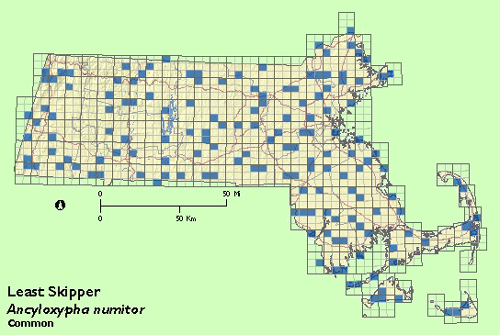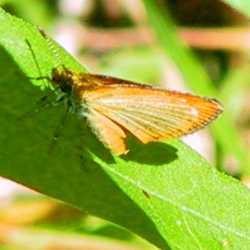Find a Butterfly
Least Skipper
Ancyloxypha numitor
Named
Fabricius, 1793

Identification
Wingspan 3/4-1", our smallest skipper. Most similar to European Skipper, but smaller and narrow-winged, with forewings above largely blackish and hindwings above orange with wide black borders. When resting in the closed-wing position the uniform mustard-yellow underwing is apparent. Slow, weaving flight characteristic.
Distribution
Southeastern Saskatchewan east to Nova Scotia and south throughout the eastern United States to Texas and Florida. In New England, absent from northern Vermont, New Hampshire, and Maine; otherwise, widespread.
Status in Massachusetts
Common throughout the Commonwealth, including the Islands. Easily overlooked because of it habit of flying through grasses. The Least Skipper can be found in moderately large concentrations of twenty or more individuals. Maximum: 150 at Pekinese Island (Barnstable Co.), 3 July 1986.

Flight Period in Massachusetts
Three flights, with adults from early June to mid-July, late July to late August, and late August to early October. Extreme dates: 29 May 1987 Sheffield (Berkshire Co.), E. Dunbar and 16 October 1994, Gloucester (Essex Co.), D. Savich and C. Tibbetts.. Scudder reported the species "nearly to the end of September" but gave no specific dates.
Larval Food Plants
Grasses, including Rice Cutgrass (Leersia oryzoides), Panic Grass (Panicum, sp.), Bluegrass (Poa, sp.), Foxtail Grass (Setaria, sp.), Cordgrass (Spartina, sp.), and Marsh Millet (Zizaniopsis miliacea).
Adult Food sources
Found nectaring on 27 species of flowering plants by atlas workers including Ox-eye Daisy, Red Clover, Cow Vetch, and Rough-fruited Cinquefoil.

Habitat
Most often found in grasses and thick vegetation in moist situations, such as along brooks and pond edges and in wet meadows. Occurs more sparingly in open, drier meadows.
Life Cycle
EGG: Bright yellow, unmarked when fresh but soon acquiring a reddish band; hemispherical. OVIPOSITION: Eggs laid singly on grass. LARVA: Light green body, with blackish-brown head, ringed with white on the front. CHRYSALIS: Off-white, with brown and black spots and lines: slender. PUPATION: Frequently pupates on Marsh Millet over water (Pyle, 1951). OVERWINTERING: third or fourth instar larvae.
Caterpillars emerge in spring and feed on host grasses, mostly in wet areas. Males patrol for females with a slow, steady flight, unlike that of most other skippers, through medium to tall grasses.
Account Author
Brian Cassie



